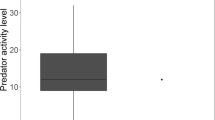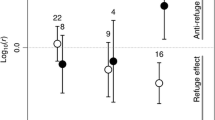Summary
Prey species may use many different behaviours to avoid predation. In this study, the antipredator behaviours of juvenile roach (Rutilus rutilus) and juvenile perch (Perca fluviatilis) were studied in wading pools with three kinds of structural complexity: no structure, structure simulating vegetation and structure simulating bottom crevices. Predation experiments with piscivorous perch and habitat choice experiments with the prey were performed, and the foraging success and prey choice of the predators were related to the type of structure. Predator foraging success was lower in the vegetation than in the other treatments. In the absence of structure and with vegetation structure, predators preferred perch over roach, while the preference was reversed in the crevice treatment. Roach and perch differed in their antipredatory behaviours. Roach responded to the presence of predators by schooling, moving fast and remaining at the surface, and escaped from attacks by jumping out of the water. In contrast, perch moved more slowly, dispersed after attacks and tried to hide at the bottom. Perch always preferred the vegetation structure to the non-structured part of the pool, while roach showed preference for the vegetation structure only when predators were present. Roach never occurred in crevices, whereas perch used crevices when predators where present. Predator pursuit speed was lower in the vegetation structure than in the non-structured treatment, but prey escape speed was unaffected. The results suggest that both the quantity and quality of structural complexity interacting with species-specific antipredator behaviours are important for predator-prey dynamics. It is also suggested that the presence of structure can have substantial effects on the structure of North Eurasian fish communities, by affecting relative and absolute predation pressures from piscivorous perch on prey species.
Similar content being viewed by others
References
Anderson O (1984) Optimal foraging by largemouth bass in structured environments. Ecology 65:851–861
Berger J (1978) Group size, foraging, and antipredator ploys: an analysis of bighorn sheep decisions. Behav Ecol Sociobiol 4:91–99
Bertram BCR (1980) Vigilance and group size in ostriches. Anim Behav 28:278–286
Beyerle GB, Williams JE (1968) Some observations on food selectivity by northern pike in aquaria. Trans Am Fish Soc 97:28–31
Caldwell GS (1986) Predation as a selective force on foraging herons: effects of plumage color and flocking. Auk 103:494–505
Calvert WH, Hedrick LE, Brower LP (1979) Mortality of the monarch butterfly, Danaus plexxippus: avian predation at five overwintering sites in Mexico. Science 204:847–851
Caraco T (1979a) Time budgeting and group size: a theory. Ecology 60:611–617
Caraco T (1979b) Time budgeting and group size: a test of a theory. Ecology 60:618–627
Caraco T, Martindale S, Pulliam HR (1980) Flocking: advantages and disadvantages. Nature 285:400–401
Coull BC, Wells JBJ (1983) Refuges from fish predation: experiments with phytal meiofauna from the New Zealand rocky intertidal. Ecology 64:1599–1609
Crook JH (1965) The adaptive significance of avian social organizations. Symp Zool Soc London 14:181–218
Crowder LB, Cooper WE (1982) Habitat structural complexity and the interaction between bluegills and their prey. Ecology 63:1802–1813
Diehl S (1988) Foraging efficiency of three freshwater fishes: effects of structural complexity and light. Oikos 53:207–214
Duncan P, Vigne N (1979) The effect of group size in horses on the rate of attacks by blood-sucking flies. Anim Behav 27:623–625
Eklöv P, Hamrin SF (1989) Predatory efficiency and prey selection: interactions between pike Esox lucius, perch Perca fluviatilis and rudd Scardinus erythrophthalmus. Oikos 56:149–156
Foster WA, Treherne JE (1981) Evidence for the dilution effect in the selfish herd from fish predation on a marine insect. Nature 295:466–467
George CJW (1960) Behavioral interactions of the pickerel (Esox niger and Esox americanus) and the mosquitofish (Gambusia patruelis). PhD thesis, Harvard University
Gillen AL, Stein RA, Carline RF (1981) Predation by pellet-reared tiger muskellunge on minnows and bluegills in experimental systems. Trans Am Fish Soc 110:197–209
Gilinsky E (1984) The role of fish predation and spatial heterogeneity in determining benthic community structure. Ecology 65:455–468
Gilliam JF, Fraser DF (1987) Habitat selection under predation hazard: a test of a model with foraging minnows. Ecology 68:1856–1862
Glass NR (1971) Computer analysis of predation energetics in the largemouth bass. In: Patten BC (ed) Systems analyses and simulation ecology, vol. 1. Academic Press, New York, pp 325–363
Helfman GS (1986) Behavioural responses of prey fishes during predator-prey interactions. In: Fender ME, Lauder GV (eds) Predator-prey relationships: perspectives and approaches from the study of the lower vertebrates. University of Chicago Press, Chicago, pp 135–156
Holmes WG (1984) Predation risk and the feeding of the hoary marmot in Alaska. Behav Ecol Sociobiol 15:293–301
Holomuzki JR (1986) Habitat use and fish avoidance behaviors by the stream-dwelling isopod Lirceus fontinalis. Oikos 52:79–86
Ives AR, Dobson AP (1987) Antipredator behaviour and the population dynamics of simple predator-prey systems. Am Nat 130:431–447
Jeffries MJ, Lawton JH (1984) Enemy free space and the structure of ecological communities. Biol J Linn Soc 23:269–286
Johansson L (1987) Experimental evidence for interactive habitat segregation between roach (Rutilus rutilus) and rudd (Scardinus erythrophthalmus). Oecologia 73:21–27
Johansson L, Persson L (1986) The fish community of temperate eutrophic lakes. In: Riemann B, Söndergaard M (eds) Carbon dynamics of eutrophic temperate lakes: the structure and functions of the pelagic environment. Elsevier, Amsterdam, pp 237–266
Kenward RE (1978) Hawks and doves: factors affecting success and selection in goshawk attacks on wood-pigeons. J Anim Ecol 47:449–460
Lazarus J (1979) The early warning function of flocking in birds: an experimental study with captive Quela. Anim Behav 27: 855–865
Magurran AE (1990) The adaptive significance of schooling as an anti-predator defence in fish. Ann Zool Fenn 27:51–66
Magurran AE, Pitcher TJ (1987) Provenance, shoal size and the sociobiology of predator evasion behaviour in minnow schools. Proc Roy Soc London 229:439–465
Mauck WL, Coble DW (1971) Vulnerability of some fishes to northern pike (Esox lucius) predation. J Fish Res Bd Can 28:957–969
Milinski M (1979) Can an experienced predator overcome the confusion of swarming prey more easily? Anim Behav 27:1122–1126
Milinski M, Heller R (1978) Influence of a predator on the optimal foraging of sticklebacks (Gasterosteus aculeatus L.) Nature 27:642–644
Neill Sr StJ, Cullen JM (1974) Experiments on whether schooling by their prey affects the hunting behaviour of cephalopods and fish predators. J Zool London 172: 549–569
Nonacs P, Dill LM (1990) Mortality risks versus food quality tradeoffs in a common currency: ant patch preferences. Ecology 71:1886–1892
Paine RT (1974) Intertidal community structure: Experimental studies on the relationship between a dominant competitor and its principal predator. Oecologia 15:93–120
Parrish J (1989) Re-examining the selfish herd: are central fish safer? Anim Behav 38:1048–1053
Persson L (1987) Effects of habitat and season on competitive interactions between roach (Rutilus rutilus) and perch (Perca fluviatilis). Oecologia 73:170–177
Persson L (1988) Asymmetries in competitive and predatory interactions in fish populations. In: Ebenman B, Persson L (eds) Size-structured populations — ecology and evolution. Springer Verlag, Berlin Heidelberg New York, pp 203–218
Persson L (1991a) Behavioral response to predators reverses the outcome of competition between prey species. Behav Ecol Sociobiol 28:101–105
Persson L (1991b) Interspecific interactions. In: Winfield IJ, Nelson JS (eds) The biology of cyprinid fishes. Chapman and Hall, London New York, pp 530–551
Persson L, Greenberg LA (1990) Juvenile competitive bottlenecks: The perch (Perca fluviatilis)-roach (Rutilus rutilus) interaction. Ecology 71(1):44–56
Pierce CL (1988) Predator avoidance, microhabitat shift, and risk-sensitive foraging in larval dragonflies. Oecologia 77:81–90
Pitcher TJ (1986) Functions of shoaling behaviour in teleosts. In: Pitcher TJ (ed) The behaviour of teleost fishes. Croom Helm, London, pp 294–337
Power ME (1987) Predator avoidance by grazing fishes in temperate and tropical streams: Importance of stream depth and prey size. In: Kerfoot WC, Sih A (eds) Predation. Direct and indirect impacts on aquatic communities. University Press of New England, Hanover, London, pp 333–352
Pulliam HR, Caraco T (1984) Living in groups: is there an optimal group size? In: Krebs JR, Davies NB (eds) Behavioural ecology: an evolutionary approach. Blackwell Scientific Publications, Oxford, pp 122–147
Rahel FJ, Stein RA (1988) Complex predator-prey interactions and predator intimidation among crayfish, piscivorous fish, and small benthic fish. Oecologia 75:94–98
Reist JD (1980) Selective predation upon pelvic phenotypes of brook stickleback, Culaea inconstans, by northern pike, Esox lucius. Can J Zool 58:1245–1252
Savino JF, Stein RA (1982) Predator-prey interaction between largemouth bass and bluegills as influenced by simulated, submersed vegetation. Trans Am Fish Soc 111:255–266
Savino JF, Stein RA (1989a) Behavioural interactions between fish predators and their prey: effects of plant density. Anim Behav 37:311–321
Savino JR, Stein RA (1989b) Behavior of fish predators and their prey: habitat choice between open water and dense vegetation. Environ Biol Fish 24:287–293
Schramm HL, Zale AV (1985) Effects of cover and prey size on preferences of juvenile largemouth bass for blue tilapias and bluegills in tanks. Trans Am Fish Soc 114:725–731
Sih A (1987) Prey refuges and predator-prey stability. Theor Popul Biol 31:1–12
Sih A, Moore RD (1990) Interacting effects of predator and prey behaviour in determining diets. In: Hughes RN (ed) Behavioural mechanisms of food selection. (Nato ASI Series, Vol. G 20) Springer Verlag, Berlin Heidelberg New York
Stein RA (1977) Selective predation, optimal foraging, and the predator-prey interaction between fish and crayfish. Ecology 58:1237–1253
Wardle CS (1986) Fish behaviour and fishing gear. In: Pitcher TJ (ed) The behaviour of teleost fishes. Croom Helm, London, pp 463–495
Werner EE (1991) Nonlethal effects of a predator on competitive interactions between two anuran larvae. Ecology 72:1709–1720
Werner EE, Gilliam JF (1984) The ontogenetic niche and species interactions in size-structured populations. Annu Rev Ecol Syst 15:393–426
Werner EE, Gilliam JF, Hall DJ, Mittelbach GG (1983) An experimental test of the effects of predation risk on habitat use in fish. Ecology 64:1540–1548
Wilbur HM (1988) Interactions between growing predators and growing prey. In: Ebenman B, Persson L (eds) Size-structured populations — ecology and evolution. Springer Verlag, Berlin Heidelberg New York, pp 157–172
Winfield IJ (1986) The influence of simulated aquatic macrophytes on the zooplankton consumption rate of juvenile roach, Rutilus rutilus, rudd, Scardinus erythrophthalmus, and perch, Perca fluviatilis. J Fish Biol 29 (Suppl A):37–48
Author information
Authors and Affiliations
Additional information
Correspondence to: B. Christensen
Rights and permissions
About this article
Cite this article
Christensen, B., Persson, L. Species-specific antipredatory behaviours: effects on prey choice in different habitats. Behav Ecol Sociobiol 32, 1–9 (1993). https://doi.org/10.1007/BF00172217
Received:
Accepted:
Issue Date:
DOI: https://doi.org/10.1007/BF00172217




